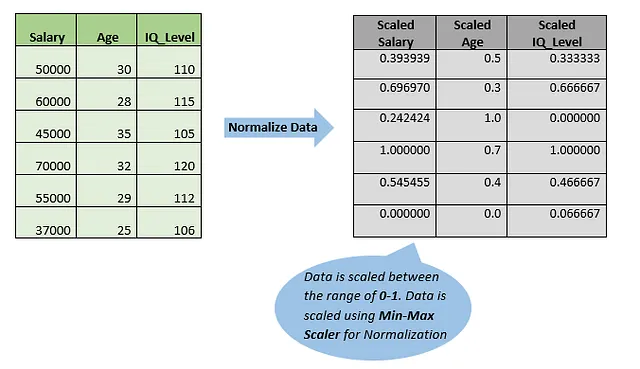This project provides various techniques and tools for preprocessing your data to improve the performance of your machine learning models.
- What is Feature Scaling?
- Why it Matters?
- Feature Scaling Techniques
- Best Practices for Feature Scaling
- Summary
- Author
Feature scaling is a data preprocessing technique used in Machine Learning to standardize or normalize the range of independent variables or features of data. Feature scaling normalizes entire features in a similar range.
↪ It is also known as data normalization.
Feature Scaling brings all features in a similar range, to ensure each feature contributes equally to training and no feature dominates over the other.
Let's assume you have a dataset with three features: Salary, Age, and IQ Level. The Salary ranges from 30,000 to 80,000, the Age ranges from 20 to 40, while IQ Level ranges from 90 to 120. If you use these features without scaling them, your machine learning algorithm might give importance to the Salary feature because it has a larger range and variance than the other two features. This could lead to a biased and inaccurate model. So, you have to scale these features for better results.
Upon analyzing this example, you now have a better understanding of feature scaling and why it is important.
Standardization, also known as z-score Normalization.
This technique transforms the features to have a mean = 0 and a standard deviation = 1. It performs best when the distribution of data is not Gaussian(Normal).
$$
Z = \frac{X - \bar{X}}{\sigma}
$$
from sklearn.preprocessing import StandardScaler
# instance for scaler
scaler = StandardScaler()
X_transform = X.fit_transform(X)Normalization re-scales values in the range of 0-1, while it doesn’t affect the original distribution and relationship of features.
↪ Normalization is also known as min-max normalizarion or min-max scaling.
Min-Max Scaling is useful when data doesn't follow a normal distribution.
from sklearn.preprocessing import MinMaxScaler
scaler = MinMaxScaler()
x_scaled = scaler.fit_transform(x_train)Max-Abs Scaler works very well in sparse data when most of the observations are 0. Max-Abs Scaler rescale each feature by its maximum absolute value. So, the maximum absolute value of each feature in the training set will be 1.0. $$ X^{'} = \frac{X}{|X_{max}|} $$
from sklearn.preprocessing import MaxAbsScaler
scaler = MaxAbsScaler()
X_transformed = scaler.fit_transform(X)Robust Scaler works well when there are outliers present in the data. Because it uses the median(x͂) and inter-quartile range(Q3 — Q1), it absorbs the impact of outliers while scaling.
from sklearn.preprocessing import RobustScaler
scaler = RobustScaler()
X_transformed = scaler.fit_transform(X)| Feature Scaling Technique | When to Use | Characteristics |
|---|---|---|
| Standard Scaler | - When the distribution of data is normal - Models assume to have Gaussian (Normal) Distribution - Models that rely on Gradient Descent method (Linear Regression and Logistic Regression) - Sensitive to Outliers |
- Assumes data follows a normal distribution. - Sensitive to outliers. |
| Max-Abs Scaler | - Suitable for sparse data, when most of the values are 0 - Sensitive to outliers |
- Works well with sparse data. - Sensitive to outliers. |
| Robust Scaler | - When data has outliers, robust scaler performs best - When data has skewed distribution |
- Performs well with outliers. - Suitable for skewed data. |
| Min-Max Scaler | - When the distribution of data is not Gaussian (Normal) - Algorithms requiring features to specific Range [0,1] - Not suitable for sparse data - Sensitive to outliers - Perform best with Neural Networks and KNN |
- Scales features to a given range, usually [0, 1]. - Sensitive to outliers. - Not suitable for sparse data. - Best for Neural Networks and KNN. |
Machine Learning revolves around experimentation, the more you get hands-on, the better your understanding of this field becomes. It’s similar to the trial and error method. Scaling the input data before feeding it to a machine learning model is always a good practice.
Scaling the input data before feeding it to a machine learning model is a best practice. Here are some key points to remember:
- Scaling accelerates model convergence: Properly scaled data can help models converge faster during training.
- Normalization: This technique scales data to a range between 0 and 1. It is particularly useful when the data does not follow a normal distribution.
- Standardization: This method scales data to have a mean of 0 and a standard deviation of 1. It is preferred for data with a normal or Gaussian distribution.
- Robust Scaling: This approach is beneficial when the data contains many outliers, as it uses statistics that are less sensitive to them.
- Experimentation is key: Often, the choice of scaling technique might not significantly affect the results, but it can in some cases. It’s good practice to try different scaling methods to see which works best for your specific dataset.
- Only scale features, not labels: Ensure that only the features (input variables) are scaled and not the target variable (labels).
- Proper usage of scalers: Do not fit the scaler on the test data. Fit the scaler only on the training data and then apply the transformation to the test data.
- Incorrect:
scaler.fit_transform(X_test) - Correct:
scaler.transform(X_test)
- Incorrect:
Implementing these practices will help in building more efficient and reliable machine learning models.
